Plants
Pot-in-Pot: Making Things Easier
Aug 26, 2009


By Tom Knight
LSOL.com Landscape Horticulture Editor |
Author
Bio
Now. . . you folks that are still here, how many of you have less than a green thumb? Just as I suspected, the majority of you. Hey! I can kill a plant with the best of them but, I am always looking for ways to avoid killing them AND I'm always trying to do things easier. That brings me to the topic of pot-in-pot. An idea "borrowed" from the plant nursery business.
|
Okay, all of you that do not want to have live plants on your outdoor large scale train layout, raise your hand. You folks may be excused. Before you leave might I suggest that you pave your back yard and do away with the weed problem that you have. Now. . . you folks that are still here, how many of you have less than a green thumb? Just as I suspected, the majority of you. Hey! I can kill a plant with the best of them but, I am always looking for ways to avoid killing them AND I'm always trying to do things easier. That brings me to the topic of pot-in-pot. An idea "borrowed" from the plant nursery business. Those guys have discovered that by growing a plant in a container (Growing Pot) while that container is inserted into a second container (sleeve or socket pot) really makes life easier. The sleeve/socket pot in turn is inserted into the ground. (See figure 1) 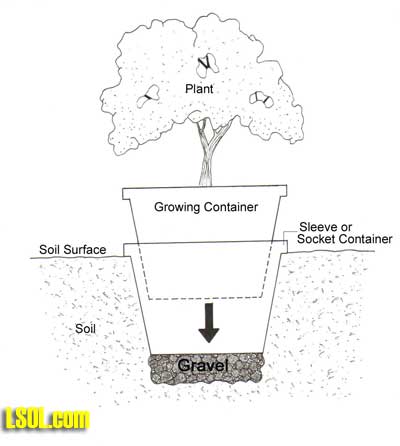 I wish I had all of the "non-plant" people back. I would want to ask them WHY do you not want to have plants? I'll bet some answers would be; ". . .plants are too much trouble to keep alive."; or , ". . . I hate having to get down on my hands and knees to prune or trim them."; or maybe "the dirt in my yard won't grow anything." The excuses can be endless.
While using pot-in pot will not solve all of the chores or problems in having plant material it can make things easier. Growing a plant in a container, in another container, isn't the whole picture. For example the guys who have dirt (see above) can easily over come their problem by using a growing media in the growing container that is much more supportive of good plant growth. Modified Growing Media Supplying correct amounts of water and fertilizer to plants is a function of a good growing media (soil if you like). Being loose (friable) enough to allow good root penetration is another characteristic of a good growing media. Did you ever look at what plants are growing in that you purchase in containers from a local nursery or garden center? Odds are there is little or no soil (definitely not dirt) in the pot. It is a "man-made" growing media. The recipe can vary from grower to grower but peat moss and/or bark are likely to make up the bulk of the media around the roots. And those little things that look like bug eggs on top? Fertilizer! Actually slow release fertilizer. Now, lets take a lesson from those growers. Let's not plant our plants in dirt, but, instead, plant them in a container with a mixture of peat moss and, say, sand and good top soil. About a 2:1:1 ratio. That is two parts peat moss + one part sand + one part top soil. That is a recipe that has worked for me. (But, trust me, there are thousands of possibilities for good growing media recipes. ) Now this combination can provide a good supply of water to the roots provided rainfall and watering is adequate. But, those combined ingredients probably will not provide adequate fertility for good healthy plants. That is where the bug eggs (OH sorry) the fertilizer comes in. You can purchase slow release fertilizer at any reputable garden center or plant nursery. All the way from small bottles for house plants up to boxes or bags weighing upwards to 40 or 50 pounds. The key is slow release. Why? You put the recommended amount (check the package) on the top of the growing media in the early spring; keep the plant adequately watered (that can be another topic for an article); and you are good for an entire growing season. Now for you folks that don't want to bother mixing your own growing media there are several good potting mixes on the market. Select a brand name potting mix such as Miracle-Grow and avoid the "Brand-X" medias. You will be glad you did.
Mechanics of Pot-In-Pot Now that we have established that we need to modify the stuff in which the plant grows, lets look at the mechanics of using the pot-in-pot technique. In the nursery business they make special growing/sleeve pot sizes but for us outdoor train folks we can simply use two containers of the same size assuming they are made with a taper on them where one will fit into the other. Most plant containers are made that way so a source of containers is not a major issue. Let's first take a look at the sleeve or socket pot. It should be buried in the soil so that the top of the container is flush or slightly above the surface of the ground. It doesn't really matter as long as the top of this container is eventually hidden with a mulch cover, (See figure 2) 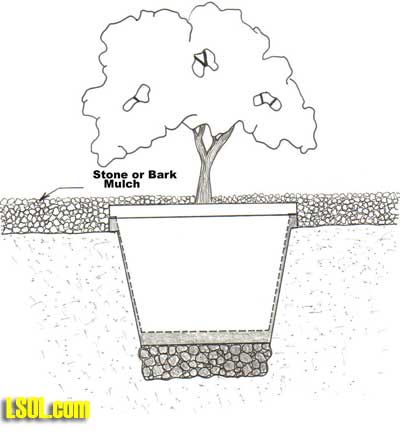 One problem that might be encountered with this sleeve or socket pot is that it might have a tendency to "stick" to the growing container if there is a need to pull the growing pot (with the plant in it) out. The idea is to have the socket/sleeve pot to stay in the ground to accept the growing pot when replaced.
There are at least a couple of easy ways to avoid this possible problem. One is to anchor the socket/sleeve pot in the ground. I use short pieces of steel rebar poked through the pot and protruding out the sides. (See Figure 03) 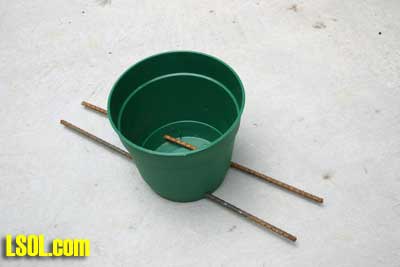 The pot is then buried with the rebar sticking out into the soil. This will typically be enough of an anchor to hold the pot in the ground. (See Figure 04) 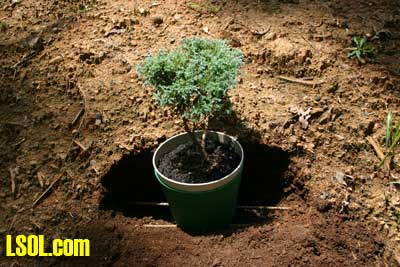 Another option is to place a spacer such as a brick or block of wood in the bottom of the socket/sleeve pot to keep the growing pot from coming into direct contact with the socket/sleeve pot. (See figures 5 and 6) This will cause the growing pot to be perched a little higher but if a good layer of mulch is applied no one will be the wiser. 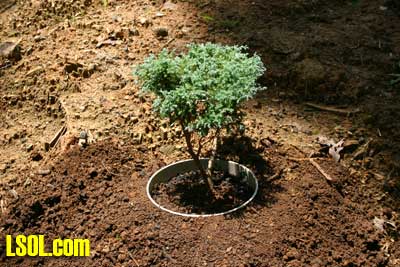
So . . . why bother? 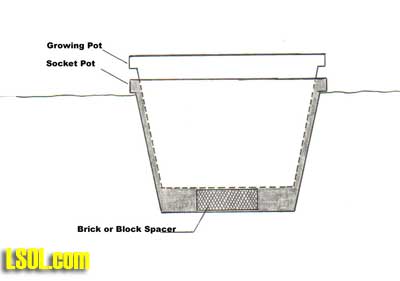 There are several benefits of planting your major plants in containers. Particularly if you are an old codger like me who hates to get down on your hands and knees to maintain your plants like shaping and pruning a plant to look like a miniature tree. I can simply pull the plant out still in the growing pot; take it to a comfortable work bench or table; do my work such as pruning or adding slow release fertilizer, etc; then stick the plant back in the ground in the socket or sleeve pot; drag a little mulch back over the pot; and I'm done! (See Figure 07) 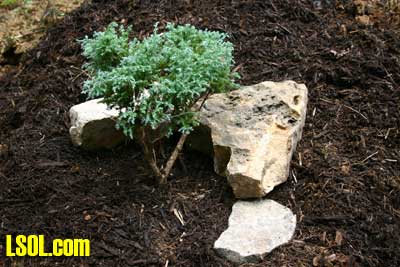 A second advantage is that if (heaven forbid!) your green thumb fails you and the plant dies, replacement is a snap. A third advantage is to again "borrow" a technique from the ancient art of bonsai. I personally want my trees to look to scale. The art of bonsai is to make plants to appear as miniature versions of their larger prototypes in the great outdoors. By occasionally removing the plant from the growing container, and carefully cutting a few of the main roots away, and adding a little more modified growing media you can cause the plant to grow in a restricted manner (as a bonsai). Of course this "root pruning" must be done in conjunction with careful top pruning to get the desired affect. (that could be a topic for another article!) Finally, if you have a desirable specie that isn't particularly hardy in your region because it gets too cold you can remove the plant (in the growing pot); set in a protected garage or basement for the winter; and replace it back into the sleeve/socket pot in the spring. Be sure to water it occasionally during the winter even though it might be dormant.
So . . . what's the down side? Nothing is perfect. There ARE some things that you must be aware of when you are restricting a plant in a container. Most importantly is watering. If the roots are bound by the size of the container they cannot spread out to glean water from the surrounding soil. That makes watering critical. Particularly if rainfall is not sufficient enough to keep adequate moisture to the roots. But constant saturation of the growing media is probably as bad as not enough water. What is the happy median? Well it is best to saturate the growing media; allow the media to dry out; and then saturate again. If natural rainfall does not do this naturally, then (occasionally) water well to make it happen. I use a drip irrigation system (several types available from garden centers) to soak several plants at a time which makes it easier than watering individual plants. (Hey, I said I look for ways to do things easier!) Okay, it rains cats and dogs for a week or you over water for whatever reason. A plant could get too much water and croak due to drowning over time. I avoid this by placing about three or four inches of coarse gravel beneath the sleeve/socket pot for extra drainage. (Refer back to figure 01) Another thing that must be considered is the fact that plants will have a tendency to grow roots out of the growing pot drainage holes; into the socket/sleeve pot; and even possibly out the sleeve/socket pot drainage holes into the ground. This can easily be eliminated by pulling the plant out of the growing pot and give it a good root pruning every year or so. I know it sounds like a lot of work but once it is done you can easily maintain your major plantings on a "garden" train setting. Let me conclude by itemizing some of the major benefits of a pot-in-pot planting: - Saves back breaking work when a plant is in need of pruning or other tedious maintenance.
- You can grow the plant in an "ideal" growing media for better water and fertilizer supply.
- By restricting the roots and carefully pruning the roots and tops you can "bonsai" the plant to look more like a realistic tree on your desired scale.
- Easier to pitch a dead plant and replace if the need arises.
I like scaled down realism on my outdoor setup. This includes details on my trains, structures and plants. Try a few pot-in-pot plants on your outdoor layout. You will probably be pleasantly surprised.
| Pot in Pot |
| Tom, Thanks for the most informative article. Maybe now the CD&StL will be able to have something growing other than weeds. |
| JD Miller - 08/26/2009 - 05:44 |
| pot planting |
| I use a similar idea when cementing in the rock work around the pond. I use a pot to create a pocket hole, then either plant in the cemented in hole or use the pot in a pot method. Also helps to run a drip line at the time you are installing the rocks. Make sure the pots are large enough to allow for root growth and so they don't dry out too soon. That's one of the reasons for the gravel in the bottom as a catch basin for overwatering and wicking back up into the plant between watering. |
| Gerri Miller - 08/26/2009 - 10:24 |
| Pot in Pot Planting |
| Tom, This is good stuff thanks for the idea. I have done this type of planting with new plants that I was unfamiliar with so I could experiment where they would be happy in the yard. Some plants are picky about the amount of sun the get and it helped me to save them and find just the right spot for them in the yard. You mentioned a couple of other possible articles here so I am looking forward to those also. |
| Jerry Madsen - 08/26/2009 - 21:45 |
| Pot in Pot Landscaping |
| Tom, Not being a gardener, I have no experience with this, but it seems that you could keep a selection of plants on hand and easily swap out which ones are at the railroad. This way you could vary the landscaping according to which are blooming, your mood, or whatever. Of course, you would need a storage area, with pots in the ground, so that everything is always in a pot within a pot and easy to move. |
| Bill Ness - 09/01/2009 - 15:19 |
| Pot in Pot Landscaping |
| Tom, I?m at this stage in my new Garden Railway so I thought it was time to read your article again. My Brother-in-law is a plant Dr (PhD) and he told me to do the very things you mention in your article with a few additions. First, use clay pots. They are a bit pricy but worth it because they drain /absorb water better. Second, when you trim the top gently remove the plant form its container and trim the roots. This aids in keeping the plant from growing too rapidly. |
| Don Wells - 03/29/2010 - 14:54 |
| Pot in Pot Landscaping |
| Tom, I?m at this stage in my new Garden Railway so I thought it was time to read your article again. My Brother-in-law is a plant Dr (PhD) and he told me to do the very things you mention in your article with a few additions. First, use clay pots. They are a bit pricy but worth it because they drain /absorb water better. Second, when you trim the top gently remove the plant form its container and trim the roots. This aids in keeping the plant from growing too rapidly. |
| Don Wells - 03/29/2010 - 14:54 |
Top of Page
|



